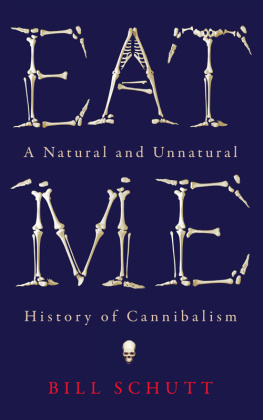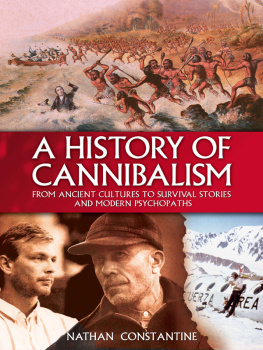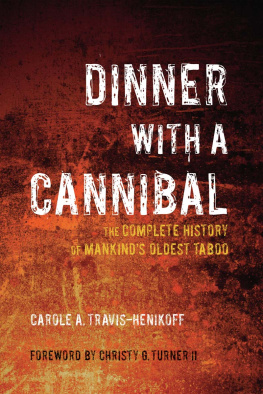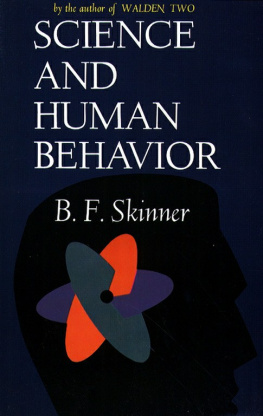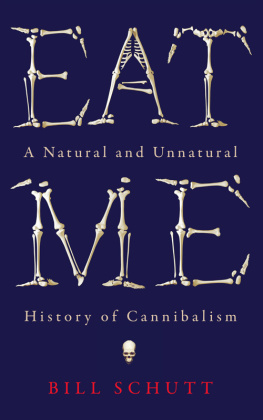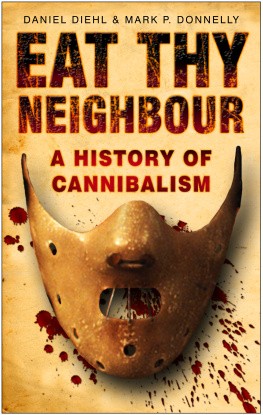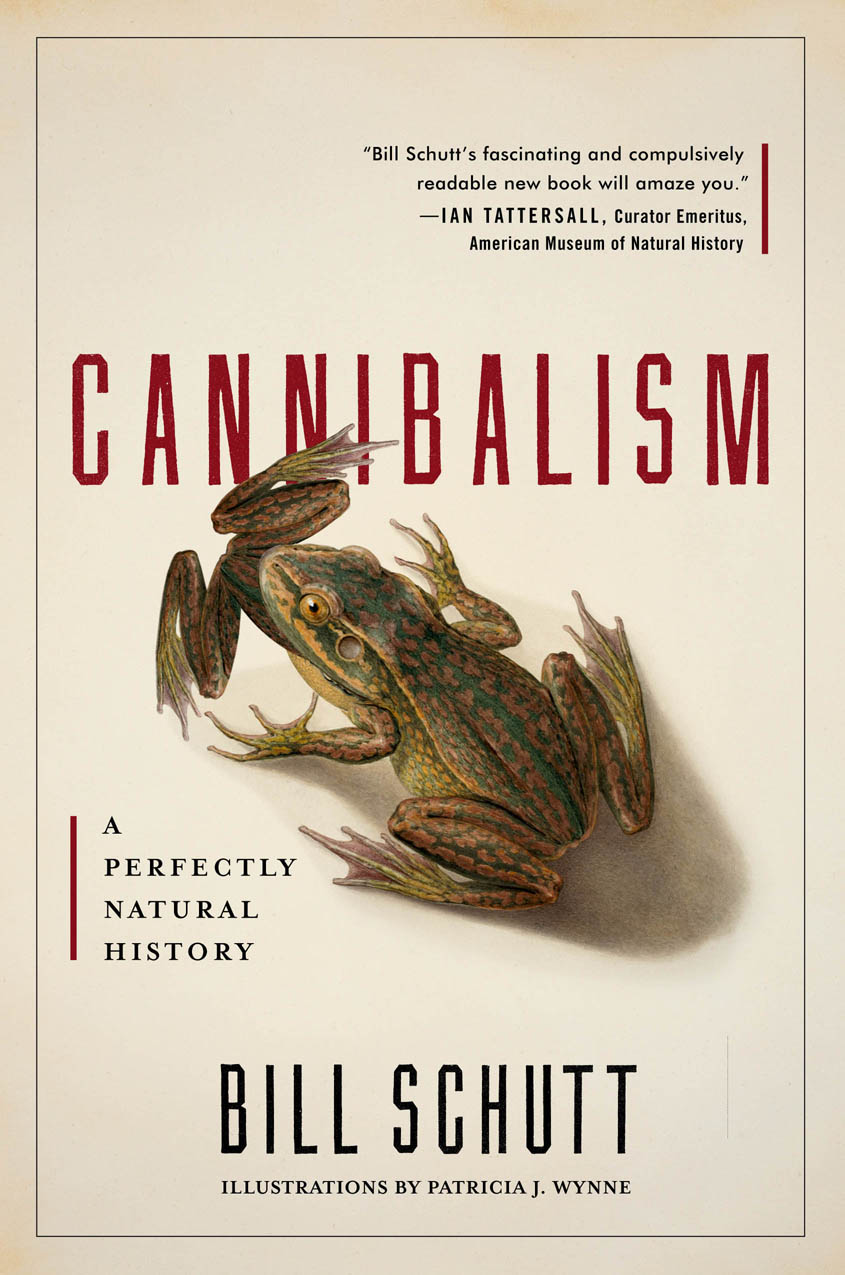Cannibalism
A Perfectly Natural History
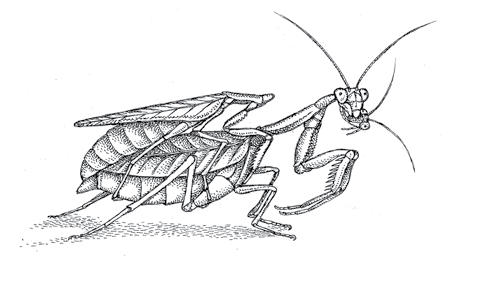
BILL SCHUTT

ALGONQUIN BOOKS OF CHAPEL HILL 2017
Also by Bill Schutt
Dark Banquet: Blood and the Curious Lives of Blood-Feeding Creatures
For Janet and Billy Schutt
And for my best friend, Robert A. Adamo (19532011)
Contents
Prologue
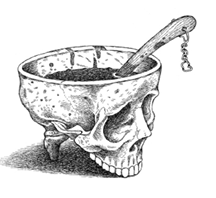
A census taker tried to quantify me once. I ate his liver with some fava beans and a big Amarone.
Thomas Harris, The Silence of the Lambs
To mark its 100-year anniversary in 2003, the American Film Institute polled a jury of 1,500 actors, writers, directors, and historians, to determine the 50 greatest screen villains of all time. Topping the AFI list was the ultimate in fictionalized cannibals, Dr. Hannibal The Cannibal Lecter. In The Silence of the Lambs, Jonathan Demmes Academy Awardwinning vision of the Thomas Harris novel, Lecter, memorably portrayed by Sir Anthony Hopkins, helps recently graduated FBI recruit Clarice Starling track down Buffalo Bill, a serial killer who skins his female victims in order to tailor a woman suit.
Second place in the poll went to Norman Bates, the mother-fixated hotel manager inhabiting Alfred Hitchcocks 1960 classic Psycho. Okay, I know what youre thinking: Norman Bates wasnt a cannibal, but just give me a minute.
From the opening scene, Hitchcock invited Eisenhower-era audiences to indulge in some long-held taboos. Filmgoers titillated the previous year by the first of the Rock Hudson/Doris Day bedroom comedies suddenly found themselves transformed into voyeurs, peering into shadowy corners previously unseen by mainstream movie audiences of the 1950s. From an amorous lunch-hour rendezvous (where the half-clad lovers had obviously just risen from their unmade hotel room bed) to a peephole in the Bates Motel, nobody would be confusing Hitchcocks masterpiece with Pillow Talk.
Released to a mixed critical response, the movie became a sensation with audiences, and remains so today. More than a half-century after its release, Bernard Herrmanns strings-only score is perhaps the most instantly recognizable music ever written for a film. Less well known is the fact that Joseph Stefanos screenplay for Psycho had been adapted from a Robert Bloch pulp novel about Wisconsin native Edward Gein (pronounced Geen), a real-life murderer, grave robber, necrophile, and cannibal.
Born in 1906, Gein lived a solitary and repressive life under the thumb of a domineering mother. The family owned a 160-acre farm, seven miles outside the town of Plainfield, but when his brother died in 1944, Gein abandoned all efforts to cultivate the land. Instead, he relied on government aid and the occasional odd job to support himself and his mother. When she died in 1945, Gein found himself alone in the large farmhouse, sealing off much of it and leaving his mothers room exactly as it looked when she was alive. The house itself fell into such serious disrepair that the neighborhood kids began claiming that it was haunted.
On the night of November 17, 1957, things began to unravel for the recluse known as Weird Old Eddie. The police were investigating the disappearance of local storeowner Bernice Worden when they got a tip that Gein had been seen in her hardware store several times that week. They picked him up at a neighbors house where he was having dinner and questioned him about the missing woman. She isnt missing, Gein told them, shes down at the house now.
Geins dilapidated farmhouse had no electricity, so the cops used flashlights and oil lamps to pick their way through the debris-laden rooms. In a shed out back, one of the men bumped into what he thought were the remains of a dressed-out deer hanging from a wooden beam. But the fresh carcass hanging upside down was no deer: It was the decapitated body of Mrs. Worden. As the stunned lawmen moved through the gruesome crime scene, it became clear that the neighborhood kids had been right. The Gein house was haunted. Each room they entered presented them with a new nightmare: soup bowls made from human skulls, a pair of lips attached to a window shade drawstring, and a belt made from human nipples. In the kitchen, the police reportedly found Bernice Wordens heart sitting in a frying pan on the stove and an icebox stocked with human organs.
Soon after Geins arrest, media correspondents from all over the world began descending on the town and its shocked populace. The reporters poked around the Gein farm and interviewed neighbors. Some of the locals recounted how theyd been given venison by Gein, who later told authorities that he had never shot a deer in his life. The Plainfield Butcher had also been a popular babysitter.
With the publication of a seven-page article in Life magazine (and a three-page spread in Time), millions of Americans became fascinated with Ed Gein and his crimes. Plainfield became a tourist attraction with bumper-to-bumper traffic crawling through the narrow streets. Jokes called Geinisms became popular.
Q: What did Ed Gein give his girlfriend for Valentines Day?
A: A box of farmer fannies.
The following year, Robert Bloch loosely adapted the Gein crimes for his novel, relocating his tale to Phoenix and concentrating on the mother-fixation aspects of the story while playing down the mutilation and cannibalism. An assistant gave Alfred Hitchcock the book and he procured the film rights soon after reading it. The director also had his staff buy up as many copies of the novel as they could find. He wanted to prevent readers from learning about the plot and then revealing its secrets. After some initial resistance from Paramount Pictures, the Master of Suspense directed his most famous and financially successful filmone that would never have been made if not for Ed Gein, a quiet little cannibal, who explained to the authorities, I had a compulsion to do it.
Is it really a surprise, though, that our greatest cinematic villain is a man-eating psychiatrist while the mild-mannered runner-up is based on a real-life cannibal killer? Perhaps not, if one considers that many cultures share the belief that consuming another human is the worst (or close to the worst) behavior that a person can undertake. As a result, real-life cannibalistic psychopaths like Jeffrey Dahmer (another Wisconsin native) and his Russian counterpart, Andrei Chikatilo, have attained something akin to mythical status in the annals of historys most notorious murderers. Whether through a filter of fictionalization, where man-eating deviants are transformed into powerful antiheroes, or through tabloids sensationalizing the crimes of real-life cannibals, these tales feed our obsession with all things gruesomean obsession that is now an acceptable facet of our society.
A different attitude was taken toward primitive social or ethnic groups whose members might not have shared the Western take on cannibalism taboos. At best, these savages were pegged as souls to be saved, but only if they met certain requirements. In the first half of the 20th century, for example, explorers and the missionaries who followed them ventured into the foreboding New Guinea highlands and quickly imposed one hard-and-fast rule for the locals: Cannibalism in any form was strictly forbidden.


